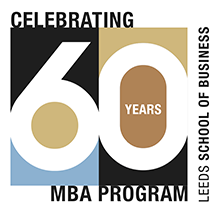LEED: Executive Leadership Program
Leadership, Ethics, Executive Decision-making: Executive Leadership Program
Do you want to gain new perspectives on your leadership in changing contexts? Interested in obtaining greater clarity of thought and vision on your personal leadership challenges? Or is your organization striving to re-energize internal leadership with greater strategic focus? The LEED (Leadership, Ethics, Executive Decision-making): Executive Leadership Program will explore these ideas and more, helping individuals realize their leadership potential and organizations flourish.
Now more than ever, organizations seek leaders who are attuned not only to the bigger picture but also can engage, influence and build cohesive, productive teams in an impactful, ethical way. The Leeds School of Business, in partnership with the University of Colorado’s Center for Leadership, offers a cutting-edge executive education program focused on organizational leadership. This highly interactive, cutting-edge program is led by CU Boulder’s world-class faculty, who bring firsthand leadership experience from private industry, the military and the U.S. government.
Participants will develop key competencies in leadership areas ranging from emotional intelligence to diversity management and developing and implementing a strategic vision. By the end, individuals will have built a toolkit of essential skills for teambuilding, motivating groups, mentoring others and forming relationships with stakeholders at all levels.
Contact LeedsExecEd@colorado.edu for any questions on the program.
Curriculum
Held on the University of Colorado Boulder’s campus in the heart of scenic Boulder, Colorado, the modular curriculum focuses on key leadership concepts for today’s dynamic business environments and includes a strong experiential component. Participants are able to put concepts into practice while sharing their own insights on leadership from across industries.
Monday - Leadership Introductions
- 9 a.m. - 9:30 a.m. Welcome with Russell Cropanzano
- 9:30 a.m. - 12 p.m. Leader Reaction Course with Emeritus Chancellor Philip DiStefano, Seth Webb and Mark Gasta
- 12 p.m. - 2 p.m. Welcome Lunch
- 2 p.m. - 5 p.m. What is a Leader with Al Pisano
Tuesday - Managing Yourself
- 9 a.m. - 12 p.m. Management Diversity with Dejun Tony Kong
- 12 p.m. - 2 p.m. Lunch Break
- 2 p.m. - 5 p.m. Politics with Tracy Jennings
Wednesday - Defining Moments
- 9 a.m. - 12 p.m. Ethical Leadership with Joshua Nunziato
- 12 p.m. - 2 p.m. Lunch Break
- 2 p.m. - 5 p.m. Teams and Team Building with Walt Morgan
- 5 p.m. - 8 p.m. Dinner and Networking
Thursday - Collaboration
- 9 a.m. - 12 p.m. Emotional Intelligence with Salma Shukri
- 12 p.m. - 2 p.m. Lunch Break
- 2 p.m. - 5 p.m. Crises and Change with Cory Cunningham
Friday - Embodying Leadership
- 9 a.m. - 12 p.m. Leadership coaching with faculty
- 12 p.m. - 2 p.m. Lunch and Wrap-up
Airport
If traveling by air, Denver International Airport is the closest major airport, located 45 minutes away from Boulder, Colorado.
Here are some transportation options to get to the University of Colorado:
Bus: CU Boulder is an hour away from the Denver International Airport (DIA) via the RTD SkyRide bus service.
Shuttle: Shared-ride service shuttles pick-up and drop-off from Jeppesen Terminal Level 5, island 5, outside doors 505-507 (east side) and 510-512 (west side).
Taxi: Taxicabs pick-up and drop-off from Jeppesen Terminal, Level 5, Island 1, outside Doors 505, 507 and 511 (Terminal East), and Doors 506, 510 and 512 (Terminal West).
Car: CU Boulder is 45 minutes away from the Denver International Airport (DIA) by car.
Learn more about renting a car from DIA
Hotel
Looking for a place to stay while in town? Boulder offers a variety of affordable hotel options located within 15 minutes of the university. View the list here.
Course Descriptions
The Leader Reaction Course was derived from military special operations assessment and selection courses. It is designed to place individuals in challenging situations which require leadership skills, decision making, creative problem solving, teamwork and effective communication. Teams will move through different “missions” rotating leadership positions with facilitators providing feedback and adjusting complexity to ensure students experience a safe, fun, challenging and impactful learning experience.
The most successful leaders are intentional about their growth and development by envisioning what type of leader they want to become and working toward that goal. But what does it mean to be a leader? And what type of leader do you want to be? To kick off this leader development course, we will begin by focusing on different ways of conceptualizing leadership and discuss ways to apply those frameworks to better understand the unique challenges of leadership. We will specifically explore the most essential leadership skills for motivating groups, mentoring others, and forming relationships with stakeholders at all levels. We will further delve into each leader’s unique leadership style, strengths, and opportunities for improvement.
Emotionally intelligence (EI) involves the ability to actively identify, understand, process, and influence one's own emotions and those of others to guide feeling, thinking, and subsequent behaviors. EI has been found to more accurately predict more effective leadership, higher productivity, greater ability to influence others, and higher salary than IQ. While we know that having high levels of EI requires understanding emotions and effectively responding to them, most of us do not know how to accurately identify our emotions or use them to their fullest purpose. It is the alignment of our emotions, thoughts, and actions that allows us to ultimately be perceived as trustworthy, credible, and influential to others. By the end of this workshop, participants will have the knowledge and tools to be able to (1) understand and appreciate the role that emotions play in providing valuable information/feedback, (2) accurately identify/differentiate their emotions, (3) interpret the correct message behind the emotions they experience, and (4) change their behavior in response to information gained from the emotion
The timeliness and importance of managing diversity is illuminated by statistics showing that workforces are becoming more heterogeneous due to immigration, globalization, and changing demographic trends in the general population. A scholarly understanding of how to manage diversity allows us to navigate common challenges that diversity can bring if mismanaged in organizations. During this segment of the program, you will be exposed to research on the topics of employee identity, maintaining business relationships across difference, the business case for diversity, and the role of inclusion. Overall, we will explore how we as business leaders can leverage diversity to create opportunities for organizations while supporting existing organizational goals.
We are in the age of collaboration. The use of teams in companies only continues to increase as the amount of time spent working on collaborative activities has ballooned by 50% or more over the past two decades. Through the use of teams, companies can become more productive and innovative – the caveat being that these teams must collaborative effectively. But, what constitutes effective collaboration and how can you develop this in your organization? Most individuals know what teamwork is and that it is useful for achieving results, but little understand the science behind effective teamwork, why this science matters, and how to use its principles to maximize team outcomes. During this segment of the program, you will be exposed to the robust science behind team building and its applicability to today’s business issues. The goal is to provide you with a foundation on what effective teamwork is and refine your team building skills so that you’re able to leverage collaboration to advance your company’s competitive edge. The segment will begin with an overview of teamwork and team effectiveness models, then we will discuss team design and team member characteristics. Following this, effective team processes and emergent states will be presented along with mitigation strategies to reduce negative processes. We will end with a discussion on team outcomes (e.g., creativity, performance) as well as how to create a collaborative corporate culture.
If leadership were black and white, it would be as easy as following a playbook. Unfortunately, business and leadership are often grey and therefore leaders must constantly make judgement calls in new situations and unfamiliar environments. It is the role of the leader to manage this grey. In order to lead in this uncertain environment, it is critical that leaders and organizations are clear on who they are and what they believe. This clarity of purpose results in sound decision making based on pre-determined criteria such as values, ethics, and established priorities. In this program, we will explore how to create this clarity of purpose and alignment to assist both individuals and organizations in reaching their fullest potential.
To remain viable in the today’s hyper-competitive business environment, the ability to adapt and change has become a key strategic competency. This module discusses the essential parts of the change process. We begin with a discussion of how organizations change and why change efforts usually fail. We then discuss the essential steps of leading change, paying special attention to challenges faced by business change agents along with methods for allaying these concerns. Key ideas are illustrated with actual business change efforts
Systems exist everywhere. We cannot avoid being part of and interacting with a wide variety of organizational, societal, technical, inter-personal, and natural systems. In business, and, more generally, at work, most of organizational challenges – problems, if you will – are systemic. That is why they are often missed or addressed only temporarily. This module will examine some of the limitations and fallacies in human thinking – when not considering systems - and we will explore some ways to overcome these limitations. Whether you are a manager working to become an executive or an executive working on the challenge of the moment, this module will show you why leaders in any field or industry need systems thinking skills in their personal and professional success.
In today’s highly volatile, uncertain, complex, and ambiguous world, successful business leaders understand that experiencing an organizational crisis is a matter of when, not if. Organizational leaders’ communication and actions before, during, and after a crisis determine if the organization survives, can recover, and ultimately utilize the crisis as an opportunity for growth. This course takes a message-centered approach to the study of crisis communication. The purpose of this course is to explore the role of communication and strategic communication practices throughout the three stages of crisis management. Both theoretical and applied research areas are considered to provide an overview of the established and emerging perspectives on risk and crisis from the communication perspective.
Executive Leadership News










